Advanced Computer Networking: Quality of Service in SDN
VerifiedAdded on 2023/06/10
|9
|1790
|433
AI Summary
This report discusses the concept of software defined networking and its architecture, with a focus on Quality of Service (QoS) in SDN. It covers three QoS approaches - FIFO Queuing, Priority Queuing, and Weighted Fair Queuing. The report also provides a list of tools that can be used to implement QoS in SDN. The subject is Advanced Computer Networking and the course code is not mentioned. The report is relevant for students pursuing computer science or networking courses in universities.
Contribute Materials
Your contribution can guide someone’s learning journey. Share your
documents today.
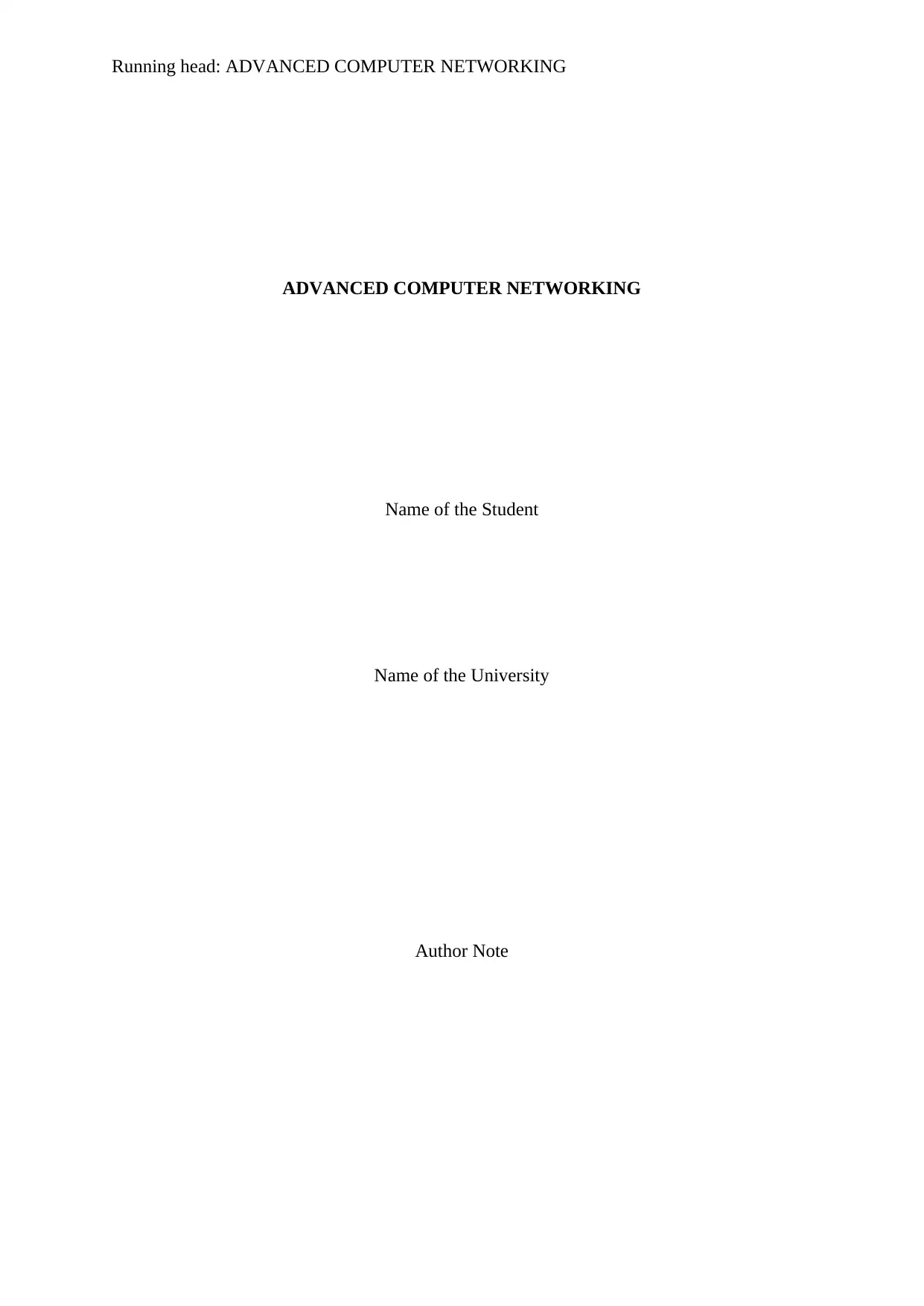
Running head: ADVANCED COMPUTER NETWORKING
ADVANCED COMPUTER NETWORKING
Name of the Student
Name of the University
Author Note
ADVANCED COMPUTER NETWORKING
Name of the Student
Name of the University
Author Note
Secure Best Marks with AI Grader
Need help grading? Try our AI Grader for instant feedback on your assignments.
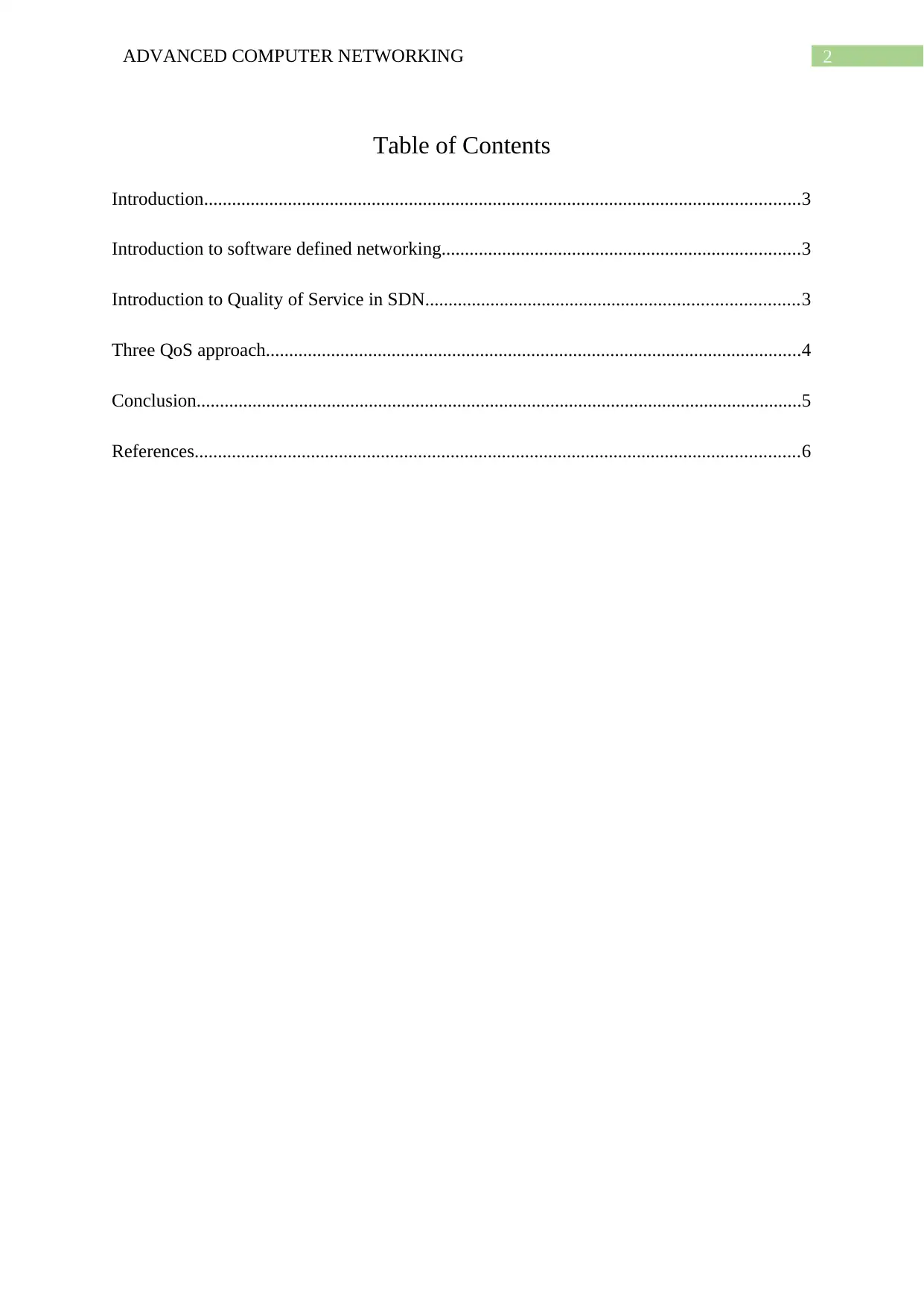
2ADVANCED COMPUTER NETWORKING
Table of Contents
Introduction................................................................................................................................3
Introduction to software defined networking.............................................................................3
Introduction to Quality of Service in SDN................................................................................3
Three QoS approach...................................................................................................................4
Conclusion..................................................................................................................................5
References..................................................................................................................................6
Table of Contents
Introduction................................................................................................................................3
Introduction to software defined networking.............................................................................3
Introduction to Quality of Service in SDN................................................................................3
Three QoS approach...................................................................................................................4
Conclusion..................................................................................................................................5
References..................................................................................................................................6
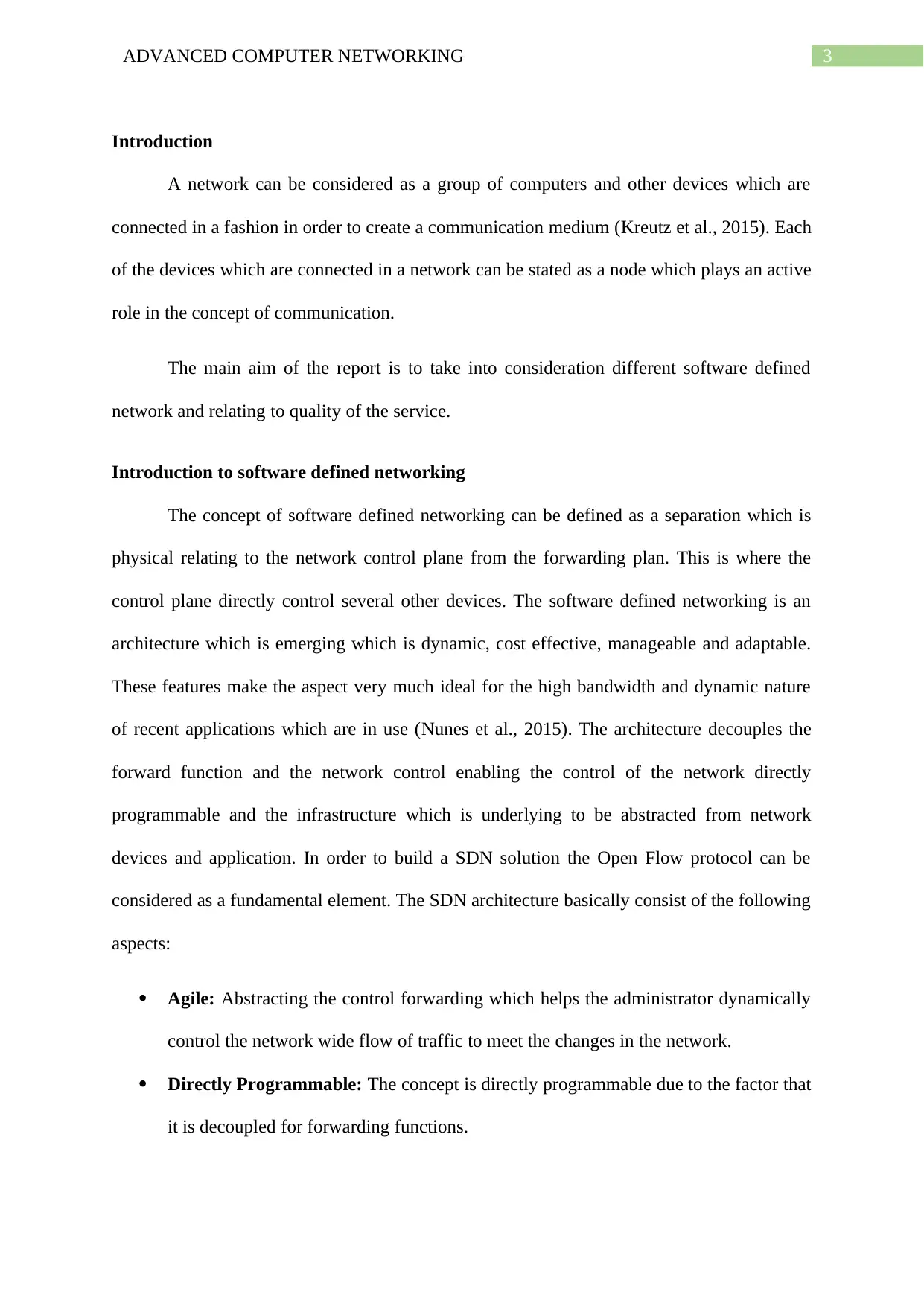
3ADVANCED COMPUTER NETWORKING
Introduction
A network can be considered as a group of computers and other devices which are
connected in a fashion in order to create a communication medium (Kreutz et al., 2015). Each
of the devices which are connected in a network can be stated as a node which plays an active
role in the concept of communication.
The main aim of the report is to take into consideration different software defined
network and relating to quality of the service.
Introduction to software defined networking
The concept of software defined networking can be defined as a separation which is
physical relating to the network control plane from the forwarding plan. This is where the
control plane directly control several other devices. The software defined networking is an
architecture which is emerging which is dynamic, cost effective, manageable and adaptable.
These features make the aspect very much ideal for the high bandwidth and dynamic nature
of recent applications which are in use (Nunes et al., 2015). The architecture decouples the
forward function and the network control enabling the control of the network directly
programmable and the infrastructure which is underlying to be abstracted from network
devices and application. In order to build a SDN solution the Open Flow protocol can be
considered as a fundamental element. The SDN architecture basically consist of the following
aspects:
Agile: Abstracting the control forwarding which helps the administrator dynamically
control the network wide flow of traffic to meet the changes in the network.
Directly Programmable: The concept is directly programmable due to the factor that
it is decoupled for forwarding functions.
Introduction
A network can be considered as a group of computers and other devices which are
connected in a fashion in order to create a communication medium (Kreutz et al., 2015). Each
of the devices which are connected in a network can be stated as a node which plays an active
role in the concept of communication.
The main aim of the report is to take into consideration different software defined
network and relating to quality of the service.
Introduction to software defined networking
The concept of software defined networking can be defined as a separation which is
physical relating to the network control plane from the forwarding plan. This is where the
control plane directly control several other devices. The software defined networking is an
architecture which is emerging which is dynamic, cost effective, manageable and adaptable.
These features make the aspect very much ideal for the high bandwidth and dynamic nature
of recent applications which are in use (Nunes et al., 2015). The architecture decouples the
forward function and the network control enabling the control of the network directly
programmable and the infrastructure which is underlying to be abstracted from network
devices and application. In order to build a SDN solution the Open Flow protocol can be
considered as a fundamental element. The SDN architecture basically consist of the following
aspects:
Agile: Abstracting the control forwarding which helps the administrator dynamically
control the network wide flow of traffic to meet the changes in the network.
Directly Programmable: The concept is directly programmable due to the factor that
it is decoupled for forwarding functions.

4ADVANCED COMPUTER NETWORKING
Managed centrally: It maintains a global network view which directly appears in the
application and the engine of logical switch.
Configured Programmatically: The concept of SDN lets the network manager to
secure, manage, configure and optimize the resources very quickly by means of
automated SDN program which are dynamic.
Vendor neutral and open standard: When implementing through the open standard,
the SDN simplifies the operation and the network design (Arslan, Sundaresan &
Rangarajan 2015). Due to the factor due to the aspect of SDN controller instead of
vendor specific protocol and devices.
Introduction to Quality of Service in SDN
The relation which is between Quality of service (QoS) and SDN can be defined as a
directly ability for a network to provide the services which are required to a traffic of selected
network. The main goal which is related to the QoS is to provide priority taking into
consideration QoS parameters which is not limited to bandwidth (Karakus & Durresi, 2017).
There are different categories in which and prominent ways in which the QoS can benefit
from the concept of SDN: inter domain routing, multimedia flow mechanism of routing,
mechanism of resource reservation, quality of experience (QoE) – aware mechanisms. The
main invent of the software defined networking paradigm has come into active play to solve
the problem related limitations of traditional architecture of network. In the SDN the quality
of service is mainly determined by the SDN hub which provides a preconfigured OS with
mininet that are already installed and other tools and controller which are very much useful.
The Operating system which is used by the SDNHub is Ubuntu which directly lines up with
the recommendation which is related to the mininet. In addition to these all tools there are
other tools even which helps in the ease of the user to access and provide quality of service.
The list of tool are stated below:
Managed centrally: It maintains a global network view which directly appears in the
application and the engine of logical switch.
Configured Programmatically: The concept of SDN lets the network manager to
secure, manage, configure and optimize the resources very quickly by means of
automated SDN program which are dynamic.
Vendor neutral and open standard: When implementing through the open standard,
the SDN simplifies the operation and the network design (Arslan, Sundaresan &
Rangarajan 2015). Due to the factor due to the aspect of SDN controller instead of
vendor specific protocol and devices.
Introduction to Quality of Service in SDN
The relation which is between Quality of service (QoS) and SDN can be defined as a
directly ability for a network to provide the services which are required to a traffic of selected
network. The main goal which is related to the QoS is to provide priority taking into
consideration QoS parameters which is not limited to bandwidth (Karakus & Durresi, 2017).
There are different categories in which and prominent ways in which the QoS can benefit
from the concept of SDN: inter domain routing, multimedia flow mechanism of routing,
mechanism of resource reservation, quality of experience (QoE) – aware mechanisms. The
main invent of the software defined networking paradigm has come into active play to solve
the problem related limitations of traditional architecture of network. In the SDN the quality
of service is mainly determined by the SDN hub which provides a preconfigured OS with
mininet that are already installed and other tools and controller which are very much useful.
The Operating system which is used by the SDNHub is Ubuntu which directly lines up with
the recommendation which is related to the mininet. In addition to these all tools there are
other tools even which helps in the ease of the user to access and provide quality of service.
The list of tool are stated below:
Secure Best Marks with AI Grader
Need help grading? Try our AI Grader for instant feedback on your assignments.
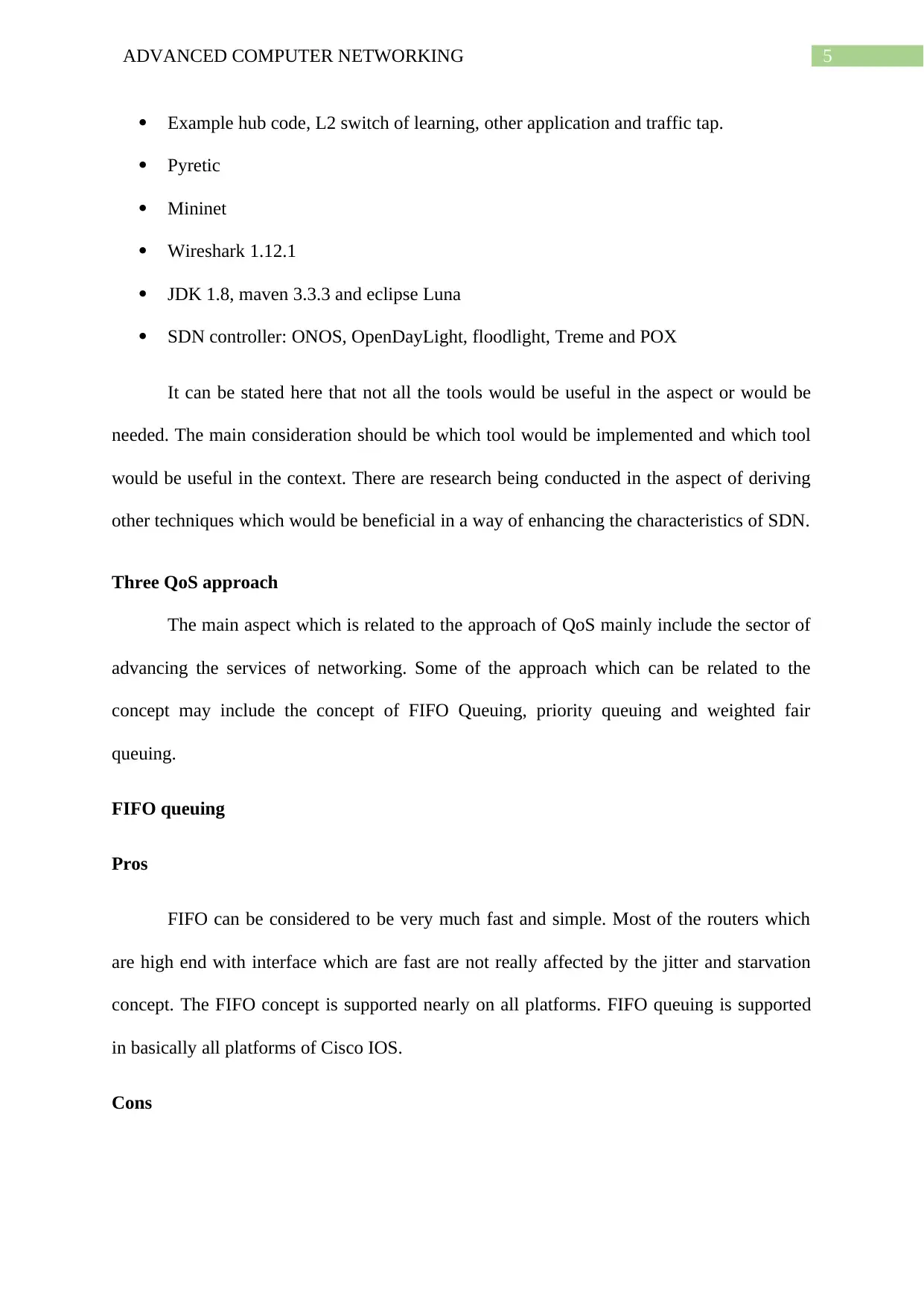
5ADVANCED COMPUTER NETWORKING
Example hub code, L2 switch of learning, other application and traffic tap.
Pyretic
Mininet
Wireshark 1.12.1
JDK 1.8, maven 3.3.3 and eclipse Luna
SDN controller: ONOS, OpenDayLight, floodlight, Treme and POX
It can be stated here that not all the tools would be useful in the aspect or would be
needed. The main consideration should be which tool would be implemented and which tool
would be useful in the context. There are research being conducted in the aspect of deriving
other techniques which would be beneficial in a way of enhancing the characteristics of SDN.
Three QoS approach
The main aspect which is related to the approach of QoS mainly include the sector of
advancing the services of networking. Some of the approach which can be related to the
concept may include the concept of FIFO Queuing, priority queuing and weighted fair
queuing.
FIFO queuing
Pros
FIFO can be considered to be very much fast and simple. Most of the routers which
are high end with interface which are fast are not really affected by the jitter and starvation
concept. The FIFO concept is supported nearly on all platforms. FIFO queuing is supported
in basically all platforms of Cisco IOS.
Cons
Example hub code, L2 switch of learning, other application and traffic tap.
Pyretic
Mininet
Wireshark 1.12.1
JDK 1.8, maven 3.3.3 and eclipse Luna
SDN controller: ONOS, OpenDayLight, floodlight, Treme and POX
It can be stated here that not all the tools would be useful in the aspect or would be
needed. The main consideration should be which tool would be implemented and which tool
would be useful in the context. There are research being conducted in the aspect of deriving
other techniques which would be beneficial in a way of enhancing the characteristics of SDN.
Three QoS approach
The main aspect which is related to the approach of QoS mainly include the sector of
advancing the services of networking. Some of the approach which can be related to the
concept may include the concept of FIFO Queuing, priority queuing and weighted fair
queuing.
FIFO queuing
Pros
FIFO can be considered to be very much fast and simple. Most of the routers which
are high end with interface which are fast are not really affected by the jitter and starvation
concept. The FIFO concept is supported nearly on all platforms. FIFO queuing is supported
in basically all platforms of Cisco IOS.
Cons
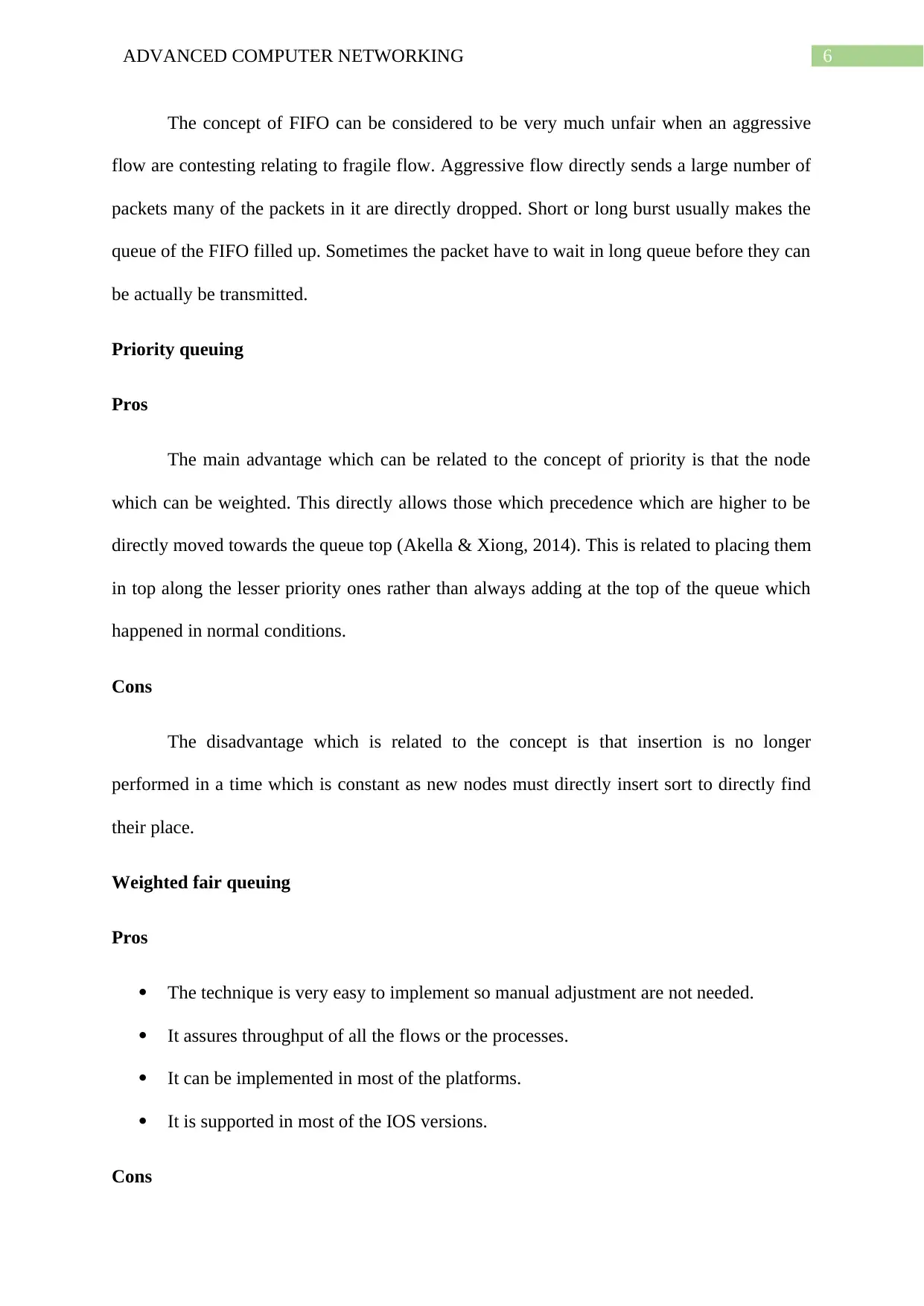
6ADVANCED COMPUTER NETWORKING
The concept of FIFO can be considered to be very much unfair when an aggressive
flow are contesting relating to fragile flow. Aggressive flow directly sends a large number of
packets many of the packets in it are directly dropped. Short or long burst usually makes the
queue of the FIFO filled up. Sometimes the packet have to wait in long queue before they can
be actually be transmitted.
Priority queuing
Pros
The main advantage which can be related to the concept of priority is that the node
which can be weighted. This directly allows those which precedence which are higher to be
directly moved towards the queue top (Akella & Xiong, 2014). This is related to placing them
in top along the lesser priority ones rather than always adding at the top of the queue which
happened in normal conditions.
Cons
The disadvantage which is related to the concept is that insertion is no longer
performed in a time which is constant as new nodes must directly insert sort to directly find
their place.
Weighted fair queuing
Pros
The technique is very easy to implement so manual adjustment are not needed.
It assures throughput of all the flows or the processes.
It can be implemented in most of the platforms.
It is supported in most of the IOS versions.
Cons
The concept of FIFO can be considered to be very much unfair when an aggressive
flow are contesting relating to fragile flow. Aggressive flow directly sends a large number of
packets many of the packets in it are directly dropped. Short or long burst usually makes the
queue of the FIFO filled up. Sometimes the packet have to wait in long queue before they can
be actually be transmitted.
Priority queuing
Pros
The main advantage which can be related to the concept of priority is that the node
which can be weighted. This directly allows those which precedence which are higher to be
directly moved towards the queue top (Akella & Xiong, 2014). This is related to placing them
in top along the lesser priority ones rather than always adding at the top of the queue which
happened in normal conditions.
Cons
The disadvantage which is related to the concept is that insertion is no longer
performed in a time which is constant as new nodes must directly insert sort to directly find
their place.
Weighted fair queuing
Pros
The technique is very easy to implement so manual adjustment are not needed.
It assures throughput of all the flows or the processes.
It can be implemented in most of the platforms.
It is supported in most of the IOS versions.
Cons

7ADVANCED COMPUTER NETWORKING
It is not possible to have one flow in every queue.
Manual classification is not allowed.
Fixed guarantees are not provided.
Its scheduling and classification concept are very much complex.
FIFO queuing Priority queuing
It is a procedural process. It is not a procedural based approach
It does not take into consideration
prioritization of packets which are sends
It does take into consideration prioritization
of the packets which are send.
FIFO queuing Weighted fair queuing
The packets which are send first would be
executed first
The packets would be executed according to
the weightage and the need of the packet.
Randomization cannot be created Randomization can be created
Weighted fair queuing Priority queuing
The approach is not procedural based on
weightage
It is not a procedural based approach based
on priority of the packets.
More packets can be executed at a single
time
Execution of the packet is done one by one.
It is not possible to have one flow in every queue.
Manual classification is not allowed.
Fixed guarantees are not provided.
Its scheduling and classification concept are very much complex.
FIFO queuing Priority queuing
It is a procedural process. It is not a procedural based approach
It does not take into consideration
prioritization of packets which are sends
It does take into consideration prioritization
of the packets which are send.
FIFO queuing Weighted fair queuing
The packets which are send first would be
executed first
The packets would be executed according to
the weightage and the need of the packet.
Randomization cannot be created Randomization can be created
Weighted fair queuing Priority queuing
The approach is not procedural based on
weightage
It is not a procedural based approach based
on priority of the packets.
More packets can be executed at a single
time
Execution of the packet is done one by one.
Paraphrase This Document
Need a fresh take? Get an instant paraphrase of this document with our AI Paraphraser

8ADVANCED COMPUTER NETWORKING
Conclusion
The report can be stated to having a comprehensive approach towards the different
sectors of networking. In most of the cases it can be noticed that the complexity of the
network devices leads to problem in a quality of service approach. There are different
approaches which can be implemented in the sector of quality of service approach which are
stated in the report with a differentiation given to each of the approaches.
Conclusion
The report can be stated to having a comprehensive approach towards the different
sectors of networking. In most of the cases it can be noticed that the complexity of the
network devices leads to problem in a quality of service approach. There are different
approaches which can be implemented in the sector of quality of service approach which are
stated in the report with a differentiation given to each of the approaches.

9ADVANCED COMPUTER NETWORKING
References
Akella, A. V., & Xiong, K. (2014, August). Quality of service (QoS)-guaranteed network
resource allocation via software defined networking (SDN). In Dependable,
Autonomic and Secure Computing (DASC), 2014 IEEE 12th International Conference
on (pp. 7-13). IEEE.
Arslan, M. Y., Sundaresan, K., & Rangarajan, S. (2015). Software-defined networking in
cellular radio access networks: potential and challenges. IEEE Communications
Magazine, 53(1), 150-156.
Karakus, M., & Durresi, A. (2017). Quality of service (qos) in software defined networking
(sdn): A survey. Journal of Network and Computer Applications, 80, 200-218.
Kreutz, D., Ramos, F. M., Verissimo, P. E., Rothenberg, C. E., Azodolmolky, S., & Uhlig, S.
(2015). Software-defined networking: A comprehensive survey. Proceedings of the
IEEE, 103(1), 14-76.
Lin, S. Y., Lai, C. H., Wu, C. H., & Lo, C. C. (2014). A trustworthy QoS-based collaborative
filtering approach for web service discovery. Journal of Systems and Software, 93,
217-228.
Nunes, B. A. A., Mendonca, M., Nguyen, X. N., Obraczka, K., & Turletti, T. (2014). A
survey of software-defined networking: Past, present, and future of programmable
networks. IEEE Communications Surveys & Tutorials, 16(3), 1617-1634.
Schlesinger, C., Ballani, H., Karagiannis, T., & Vytiniotis, D. (2015). Quality of service
abstractions for software-defined networks.
Zheng, Z., Zhang, Y., & Lyu, M. R. (2014). Investigating QoS of real-world web
services. IEEE transactions on services computing, 7(1), 32-39.
References
Akella, A. V., & Xiong, K. (2014, August). Quality of service (QoS)-guaranteed network
resource allocation via software defined networking (SDN). In Dependable,
Autonomic and Secure Computing (DASC), 2014 IEEE 12th International Conference
on (pp. 7-13). IEEE.
Arslan, M. Y., Sundaresan, K., & Rangarajan, S. (2015). Software-defined networking in
cellular radio access networks: potential and challenges. IEEE Communications
Magazine, 53(1), 150-156.
Karakus, M., & Durresi, A. (2017). Quality of service (qos) in software defined networking
(sdn): A survey. Journal of Network and Computer Applications, 80, 200-218.
Kreutz, D., Ramos, F. M., Verissimo, P. E., Rothenberg, C. E., Azodolmolky, S., & Uhlig, S.
(2015). Software-defined networking: A comprehensive survey. Proceedings of the
IEEE, 103(1), 14-76.
Lin, S. Y., Lai, C. H., Wu, C. H., & Lo, C. C. (2014). A trustworthy QoS-based collaborative
filtering approach for web service discovery. Journal of Systems and Software, 93,
217-228.
Nunes, B. A. A., Mendonca, M., Nguyen, X. N., Obraczka, K., & Turletti, T. (2014). A
survey of software-defined networking: Past, present, and future of programmable
networks. IEEE Communications Surveys & Tutorials, 16(3), 1617-1634.
Schlesinger, C., Ballani, H., Karagiannis, T., & Vytiniotis, D. (2015). Quality of service
abstractions for software-defined networks.
Zheng, Z., Zhang, Y., & Lyu, M. R. (2014). Investigating QoS of real-world web
services. IEEE transactions on services computing, 7(1), 32-39.
1 out of 9
Related Documents
Your All-in-One AI-Powered Toolkit for Academic Success.
+13062052269
info@desklib.com
Available 24*7 on WhatsApp / Email
![[object Object]](/_next/static/media/star-bottom.7253800d.svg)
Unlock your academic potential
© 2024 | Zucol Services PVT LTD | All rights reserved.





